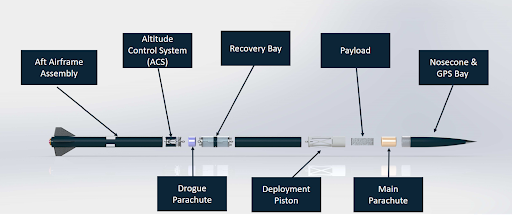To Infinity and Beyond: Senior Design Team Builds Rocket for International Competition
For years, the senior project was a chance to prove what students had learned during their time at Utah State University.
The Spaceport America Cup team took their project a step further by building rockets capable of reaching altitudes up to 30,000 ft.

Bryce Nichols, left, works on the altitude control system on the back of the rocket. The entire SpacePort America Cup team consists of Nichols, Hayden Stout, Mary Bergquist, Braxton Wiggins, Nate Schwemmer, Jonathan Sedgewick, Wyatt Lane, Jake Newberry and Gavin Morgenegg.
“If I could describe our team in one word, it'd be fun,” said Gavin Morgenegg, team lead for the project. “We're all super enthusiastic about rockets and space and we also get along super well. Every day is such a fun day.”
The team of ten consists of Hayden Stout, Bryce Nichols, Mary Bergquist, Braxton Wiggins, Nate Schwemmer, Jonathan Sedgewick, Wyatt Lane, Jake Newberry, Patrick Merighe and Morgenegg, along with project mentor Zac Foster and faculty advisor Joel Ellsworth. Each person is a pivotal part of the creation process.
The Spaceport America Cup is the largest international competition of amateur rocketry in the world, gathering over 150 teams from nearly 30 different countries. It will take place June 17-22 in New Mexico.
As a part of the group’s project, they must build a rocket approximately six feet tall capable of reaching upward of 10,000 feet. The competition rocket is named Taurus after the constellation.
An average week is jam packed with individual tasks — four sub-teams work on the airframe, recovery system, altitude control system and the payload. The team meets every week to discuss the progress of their responsibilities, which is reported to Morgenegg.
“I keep tabs on how each sub-team is doing and make sure that everybody's keeping up with what they said they were going to do at the start of the week,” he said. “With a project as complex as this, which has as many moving parts as building a rocket does, there needs to be somebody who oversees the whole thing, who's pretty familiar with the whole process. In this case, it’s me.”
In preparation for the launch in June, test launches need to be held. The closest approved launch site is in Las Vegas, so this December, the team drove down to observe what parts of their rocket needed to be improved upon. One of those pieces is the altitude control system, which deploys flaps to control the maximum altitude as the rocket ascends.

Taurus consists of eight parts with four sub-teams in charge of the airframe, recovery system, altitude control system and payload.
“When Taurus launches, it will overshoot our desired maximum altitude by about 1,000 feet,” said Morgenegg. “These flaps come out right after the motor burns out and slows down the rocket so that it hits exactly 10,000 feet. The system is novel and hasn't been successfully demonstrated before at USU. I am very proud of the team for their diligent work.”
At the test launch, the team saw significant damage to their rocket caused by the deployment of the parachute system. This mistake showed the team just how important attention to detail is.
“As in all things, failure is the best teacher,” Morgenegg said. “I spoke to our mentor the next day and I asked, what went wrong? What could we have done better? To which he responded by emphasizing the importance of extreme attention to detail in the world of rocketry. A hard, but important lesson learned.”
Morgenegg’s love for rocketry is also responsible for a side project: the rocket club, which will give students the opportunity to build rockets and explore amateur rocketry before their senior year. The goal is to help students gain experience that can help them land jobs and network in the aerospace community.
“Sure, you can learn the theory behind rocketry in classes but until you apply what you're learning, it's never going to get cemented in your brain,” he said. “The club will act as a training ground for people who want to compete in rocket competitions and get experience building rockets.”
Morgenegg admires his team and all they have accomplished. He hopes that every team member walks away with a career forming experience and shows future employers how capable they are.
“They have taught me a ton about what it means to be an engineer and what it means to be part of a team”, he said.
The Rocket Club will officially launch in mid-2024. Students, faculty and members of the community are encouraged to see the Spaceport America project during Senior Design night.
For more details, visit Senior Design Night.
###
Writer: Sydney Dahle, sydney.dahle@usu.edu, 435-797-7512
Contact: Gavin Morgenegg, gavin.morgenegg@usu.edu

